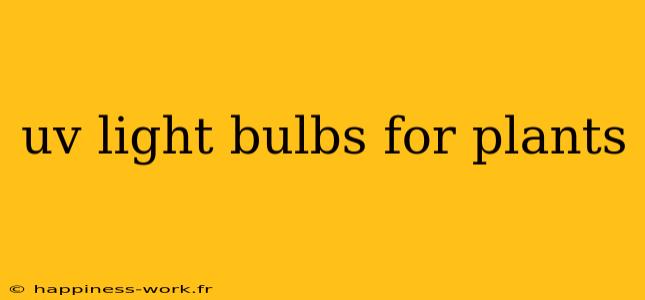When cultivating plants indoors, understanding the role of light is crucial to ensure their growth and health. Among the various lighting options, UV light bulbs have gained popularity for their potential benefits. In this article, we will explore the advantages of UV light bulbs for plants, how they work, and practical considerations for using them effectively.
What Are UV Light Bulbs?
Ultraviolet (UV) light bulbs emit light in the UV spectrum, which is invisible to the human eye. UV light can be subdivided into three categories:
- UVA: Ranges from 320 to 400 nm, known for stimulating growth and enhancing flowering.
- UVB: Ranges from 280 to 320 nm, can promote certain protective compounds in plants.
- UVC: Ranges from 100 to 280 nm, primarily used for sterilization and not suitable for plant growth.
Why Should You Consider UV Light Bulbs?
-
Enhanced Growth and Development: UV light can stimulate plant growth, particularly flowering and fruiting. According to experts on WikiHow, many plants respond positively to UV radiation, leading to increased photosynthesis and improved overall health.
-
Improved Resistance to Pests and Diseases: Exposure to UV light can help plants produce protective compounds, such as flavonoids and phenolics. These compounds not only bolster plant defenses against pests but also contribute to the plants' overall robustness.
-
Better Coloration and Flavor: Plants grown under UV light may exhibit richer colors and more intense flavors. This is particularly beneficial for edible plants like tomatoes and peppers, where enhanced pigmentation can indicate higher nutrient content.
How to Use UV Light Bulbs Effectively
Placement and Duration
-
Distance from Plants: Keep the UV light bulb at a distance of 12 to 24 inches from the plants to avoid burning them. Always check the manufacturer’s recommendations regarding safe distances.
-
Lighting Duration: Limit exposure to UV light. While plants benefit from short bursts of UV radiation, prolonged exposure can lead to damage. Aim for 4 to 6 hours of UV light exposure daily.
Choosing the Right Bulb
Not all UV bulbs are created equal. When selecting a UV bulb for your indoor plants, consider the following:
-
Full Spectrum vs. Specific UV Bulbs: Full spectrum bulbs emit a balanced range of light, including UV. They are suitable for general plant growth. Specific UV bulbs focus on UVA or UVB wavelengths for targeted benefits.
-
Energy Efficiency: LED UV bulbs are more energy-efficient and have a longer lifespan compared to traditional fluorescent UV bulbs.
Additional Tips for Successful Indoor Plant Growth
-
Monitor Plant Responses: Watch for signs of stress or damage, such as leaf burn or discoloration. Adjust the distance or duration of UV exposure as needed.
-
Complement with Other Light Sources: UV light should not be the only light source for your plants. Use it in conjunction with grow lights to provide a full spectrum of light.
-
Test with a Few Plants First: Before committing to using UV lights for all your plants, try them out on a few to see how they respond.
Conclusion
Using UV light bulbs can provide significant benefits to indoor plants, enhancing their growth, resistance to diseases, and overall quality. By understanding how to use UV light effectively, plant enthusiasts can create an ideal environment for their greenery.
Additional Resources
For more detailed insights and guides, consider checking out the following resources:
- University Extension Services: Many universities offer research-backed information on optimal lighting for various plant species.
- Gardening Forums: Online communities can provide firsthand experiences and tips from other plant enthusiasts who have successfully integrated UV light bulbs into their growth practices.
References
This article draws upon expert knowledge from WikiHow, alongside practical examples and analysis to provide a comprehensive guide on UV light bulbs for plants. Remember, experimentation and attention to your plants' responses are key to successful indoor gardening.
